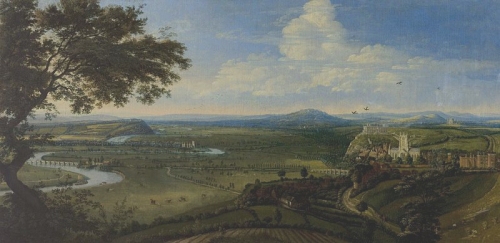On July 22nd 2010, we visited the RAF Museum at Hendon. I took a great number of photographs and these few show the Curtiss Kittyhawk IV.
First a general view of the aircraft, taken from the rear, as the museum is very, very, full. The peculiar colours are because of the strange Jacques Cousteau type lighting which is supposed to prevent deterioration of the original paint from the 1940s. They originally found some thirteen P-40s abandoned in the New Guinea jungle in 1974 but I suppose you can’t be too careful! Incidentally that was the same operation that retrieved the RAAF Beaufort I depicted a little while back:
 Here’s a second view of the Hendon P-40 with perhaps a little bit less of the “Under the Sea” effect and a lot more of that strange deep purple light made famous by the Aviator Formerly Known as Prince. Here’s a very slightly different view of the P-40. And by the way, I don’t know why the question mark is there:
Here’s a second view of the Hendon P-40 with perhaps a little bit less of the “Under the Sea” effect and a lot more of that strange deep purple light made famous by the Aviator Formerly Known as Prince. Here’s a very slightly different view of the P-40. And by the way, I don’t know why the question mark is there:
And here, incidentally, is that Bristol Beaufort, with the link to read about it:
One of the most interesting things about this plane is its name. Manufactured by Curtiss-Wright of Buffalo, New York, the largest aviation company in the USA during the 1930s, the P-40D and subsequent models was called the Kittyhawk by the RAF, the RAAF, the RCAF and the RNZAF as well as the South African Air Force. It was used extensively in North Africa:
The earlier P-40A, P-40B, and P-40C models were called Tomahawks. I have no idea whatsoever why, other than a sneaking feeling that it was just to confuse everybody who wasn’t aware of the story. The Kittyhawk had a more powerful engine and if you like aircraft engines, you can read a tale involving substandard or defective aircraft engines for military use, conspiracy, false testimony, gross irregularities, neglect of duty, troublemakers and a general court martial via this link. Amazingly, the paragraph you need is called “”Defective engines sold to U.S. military in World War II. It was apparently such a big story at the time that Arthur Miller wrote a play about it.
These two pictures show the most famous thing about so many P-40s and Kittyhawks. The shark’s mouth nose art:
On a P-40, the first people to use this design seem to have been the Chinese Nationalist Air Force although they seem to have thought that they were using a big cat, insofar as they were dubbed “The Flying Tigers”. They were still the most famous of the Shark’s Mouth aircraft though:
So just treat yourself to a little bit of the film “The Flying Tigers”. John Wayne at his very best:
In this film, “The Duke” actually speaks Chinese. Two words, “Ding Hao”.
In case you don’t know, “Ding Hao” means good luck, or good day or very good or fantastic and so on. Not as universally applicable a word as “Mao” in “The Deer Hunter” but not bad. It’s quite impressive when one single word is an entire language:
















































